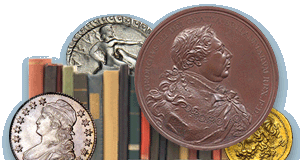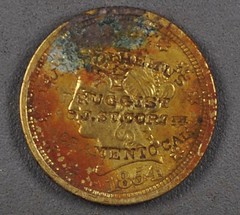
PREV ARTICLE
NEXT ARTICLE
FULL ISSUE
PREV FULL ISSUE
TREASURE TALK WITH BOB EVANS, EPISODE 7.2In January, our good friend Bob Evans began publishing a series of blog articles on the Finest Known website detailing his experience as co-discoverer and curator of the treasures recovered from the wreck of the S.S. Central America. Subject of the book "Ship of Gold", many exhibits, countless interviews and articles, books and auction catalogs feature the legendary haul of gold coins, bars, nuggets, gold dust and more from the 1857 shipwreck. Here's another excerpt - see the complete article online. -Editor One of the delights of numismatics is gazing at a circulated coin and pondering the possibilities of its circulation. How was it used? What did it pay for, and where? For the most part, details such as this are elusive, totally unknowable. Coins from the S.S. Central America have a real story. We know where they came from. There is a full record, at least from their time on the shipwreck to the time they entered the numismatic market. In a few rare instances, we can discover a little more of their stories. This is the forensic science of numismatics, part of what makes the subject sing to me. Inevitably, coins, particularly small coins, are swept up by the dredge, and they would be found by searching the sediment on deck after the dive, any significant finds taken immediately to the secure Coin Room. There were three coins found in the sediment collected during Dive 57, two seawater-effected silver coins and this little wonder. As it sat on the exam table I saw the counterstamp first. By now this was a familiar stamp to me, although it always delights me. It's one of the more spectacular counterstamps in existence, in my opinion and I'm sure that of many others. Some merchants in the 19th century used to advertise by stamping their names or the names of their businesses on circulating coins. In this case the merchant, a druggist, wanted you to know much more, and the result was a stamp that is wonderful and popular among collectors of counterstamps. Such stamps are found most commonly on silver and base-metal coins, but on the SSCA we found them on gold. I had seen this stamp before on double eagles, well-centered over the sunburst and ring of stars on the reverse (tails) side. Mr. Polhemus wanted possessors of these coins to know not only who he was, but where he was and what he did. He commissioned a logotype stamp (a single punch, instead of separate words or letters) with the full information: "J. L. POLHEMUS / DRUGGIST / 190 J. ST. COR. 7th / SACRAMENTO CAL." It's almost like you could mail these coins back to him! Adding to the charm is a miniscule mortar and pestle, just below his name. Here is the coin after curating, with the reverse surface free of rust and minerals. So, it wasn't a great rarity. According to Winter (2006, Gold Coins of the New Orleans Mint, 1839 – 1909, 2nd Edition,) in the modern numismatic market, the 1854 is one of the more readily available New Orleans quarter eagles, particularly in the lower grades. We know that gold mined in California provided almost all the supply at the New Orleans Branch Mint. So it is probable that most or all of the gold that ended up in the alloy of this quarter eagle made in New Orleans came from California. From there, the gold made it back to California, to J Street in Sacramento. We see that in the druggist's counterstamp. Then it circulated until finding its way headed back to the east on the S.S. Central America. Then it sank, and sat at the bottom of the Atlantic for 157 years until found and rescued. What an amazing trip!
To read the complete article, see:
For the complete series, see:
To read the earlier E-Sylum article, see:
Wayne Homren, Editor The Numismatic Bibliomania Society is a non-profit organization promoting numismatic literature. See our web site at coinbooks.org. To submit items for publication in The E-Sylum, write to the Editor at this address: whomren@gmail.com To subscribe go to: Subscribe All Rights Reserved. NBS Home Page Contact the NBS webmaster 
|







